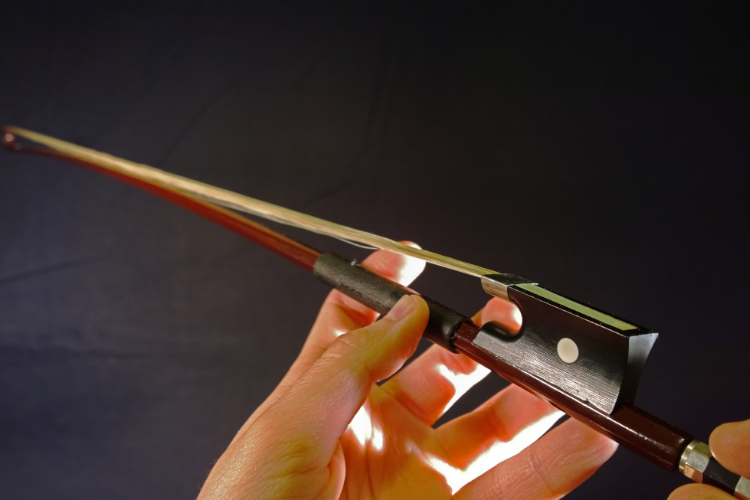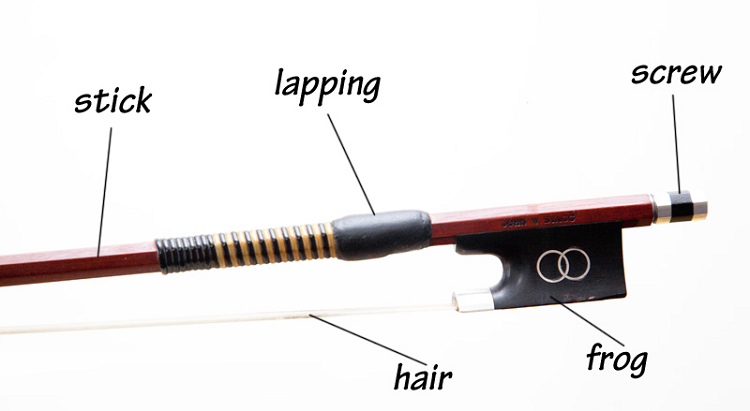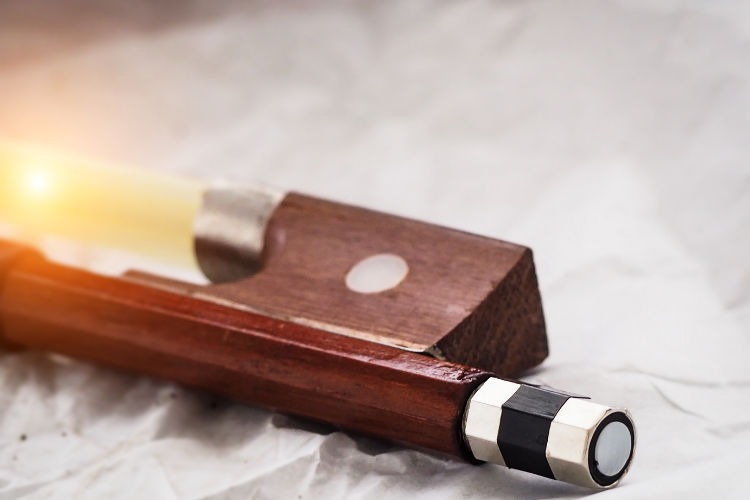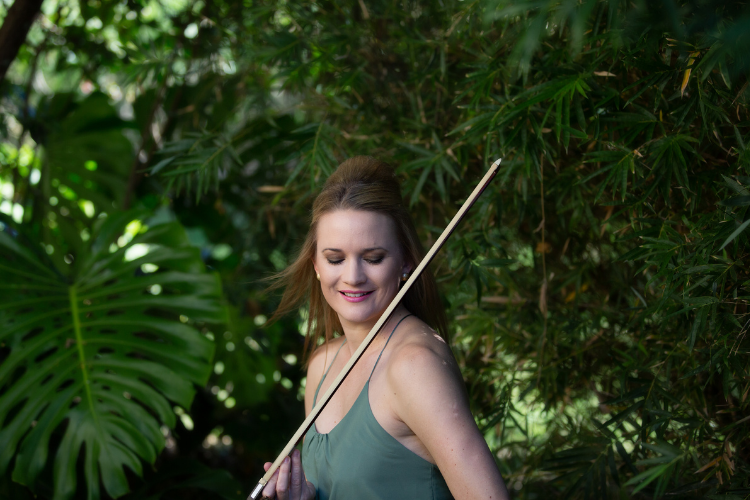- How to Clean Trumpets - May 31, 2022
- How to Find the Best 5 String Violas - May 31, 2022
- Cecilio CCO 200 Review and Guide - April 1, 2022
Purchasing your first violin can be a stressful experience. What model should you get, and do you need to consider different sizes? All of this can be quite stressful to deal with, and it’s easy to get tunnel vision, focusing solely on the violin itself.
You will need to consider other things if you plan to buy a violin, for example, which violin bow you require. I always found violin bows pretty confusing, they seem to have many more parts than the violin itself, and I didn’t know what I was doing.
Due to not understanding the parts of a bow, I ended up purchasing the wrong bow on several occasions. I did not know what I was looking for. I’ve learned a lot since then, having played the violin in an orchestra for many years, and I’m here to share what I have learned.
Whether you’re unsure about a particular violin bow part or you cannot even name me a single part, I’m sure you’ll find some useful information here, so read on to find out what I will cover.
The Bow Stick
A violin bow is a long stick-shaped object, using hair to vibrate and oscillate a violin through the act of ‘bowing.’ Violists will hold the bow in one hand by the bow stick, the core part of the bow. Traditionally, the bow is made out of a variety of different woods, but these days it is much more common to find a carbon fiber bow.
Whilst the concept of a bow stick may seem pretty easy to understand, there’s a lot more to it than simply being a stick. I’m going to break down a few different parts of the bow stick to illustrate things more clearly.
The Middle of the Bow
When you observe a violist performing, you will generally see them holding their bow stick by the middle. This is the most common and accessible area to navigate a bow from, and I would highly recommend it if you are a beginner.
I remember when I was first learning to play the violin, I would often watch highly-skilled experimental violists hold the bow in all sorts of different ways. It was very interesting to see people think outside the box, and I thought I’d give it a go myself.
My violin teacher quickly put a stop to this. Beginners should always use the middle of the bow. Learn the basics of violin playing first, and then experiment with different hold placements after.
The Balance Point
While it may seem that violinists have a firm grip on their violin bow, this is generally not the case. They instead lightly balance their bow at an angle to facilitate the soft and dynamic bowing of strings.
This is achieved through the balance point, an area where the bow will balance comfortably. This point varies between different bows, but you will generally find it around a third from the bows frog end (we’ll discuss bow frogs in more detail later).
The easiest way to locate and use the balance point of a bow is to spend some time holding it. You can try to find it based on the position of the frog end, but it’s easier to simply try out some different balance points. You’ll find the right location in no time.
Bow Stick Upper Half
Whilst the violin bow is generally held from the middle, different sections of the bow stick should be used according to the music that you are playing. The upper half of the bow stick is one example of this – it produces naturally quieter vibrations, making it useful for performing softly and broadening the instrument’s dynamic range.
It’s easy to find the bow stick upper half. It simply occupies the space between the middle of the bow stick and the tip.
Bow Stick Lower Half
Whilst the upper half of the bow stick produces quieter oscillations appropriate for softer sections of music, the lower half achieves quite the opposite.
This is generally considered to be the most difficult yet essential technique to learn on the violin. When using the lower bow stick, you will need to move your elbow upwardly, which can initially feel very counterintuitive.
It feels strange, and it’s harder to balance, but it allows us to produce the louder and more prominent oscillations heard at the tip of a crescendo. It’s equally important as the upper half, and the pair of halves are used together to reach the full dynamic range of the instrument.
The Hair
People are generally aware of two violin bow parts, the stick, and the ‘string.’ This is correct in a sense, that is not a string that you see, but a hair. These hairs are usually made of fine horsehair, often of the Siberian or Mongolian varieties.
These particular horsehairs are light and smooth, but they still have tiny fragments. When these fragments are bowed across a string, it causes an audible oscillation. However, bow hairs are sometimes made with synthetic materials to provide a vegan alternative and these work in the same way.
Unfortunately, violin bow hairs of all varieties are notorious for snapping. Much like pesky strings and reeds, hairs need replacing, and breaking one is unavoidable. Even if the horsehair quality is good, a highly dynamic performance will eventually snap it.
So, I would suggest not worrying too much about the horsehair variant as a beginner, but instead, become familiar with how to replace a broken bow hair. You will inevitably snap a hair eventually, so it’s best to come prepared.
The Thumb Leather
Holding and using a violin bow without a thumb leather would be difficult. This piece of leather helps violinists to hold their bow with balance, with some choosing to place their hand next to it, with others placing their thumb on it for rebalancing.
In addition to providing grip when using a violin bow, it also protects the wood that would be touched by the human hand. This stops the wood from getting eroded, whilst also providing a soft surface for the hand. As a result, thumb leathers wear out over prolonged use, so it’s always good to have a spare one to hand.
I customized my thumb leather when I was a student, choosing yellow over black to brighten up my performances!
The Bow Frog
Due to a violin bow consisting of a hair running parallel to a stick, the oscillations of a violin completely rely on the hair vibrating without interruption. If the hair were to touch the stick even slightly, the oscillation would disappear instantly.
This is ultimately prevented by the bow frog, a small piece of material placed between the screw and the grip of the bow that stops the stick from contacting the hair. This works with flexibility in mind, with the bow still having room to curve without affecting the vibrations of the hair.
In addition to separating the stick from the hair, the bow frog also acts as a release mechanism for the hair. For example, if you needed to remove a faulty bow hair, you would have to learn your way around the bow frog.
I remember when I first purchased a violin, there were so many different bow frogs available to purchase. However, these variations are mainly down to decorative elements, with some people sprucing up their violins with colored or shiny bow frogs. I was only a beginner and they were really expensive, so I just stuck to the plain one on my beginner violin.
The Tip
A bow tip can be found at the top of the bow stick’s upper half, in addition to being attached to the end of the hair. The tip is usually made out of wood, a piece that is very small yet perfectly suited for attaching the bow stick and the bow.
If you head to a violin shop, people will often tell you that you shouldn’t worry about the qualities of the bow tip. Generally, this is good advice for beginners, but the bow tip is very important to professional violists.
The weight of the tip can change the attachment tension between the bow stick and the hair, and this will result in a slight alteration of timbre. Seasoned violinists and experts have debated about the perfect tip weight for decades, but it is generally agreed that it should be not too heavy or light, but just right.
The Tip Plate
The tip plate of a violin bow is essential, yet not that many people know about it. This little bow part achieves three key things – it reinforces the surrounding bow structure, protects the bow tip, and can also be decorative.
Tip plates come in pretty standard forms, and even budget violins should have a suitable tip plate fitted. However, many people choose to purchase violins with pretty tip plates made from a variety of shiny materials.
The Winding
The winding of a violin bow can be found as a metal material (often nickel) placed next to the thumb leather. It essentially provides an additional protective layer between the wood and the performer’s hand, but they often come in glamorous and expensive forms found on some very expensive violin bows.
The Screw
Another essential yet small part of a violin bow is the screw. This can be found at the end of a bow next to the tip and facilitates the loosening and tightening of the bow hair.
Much like many other instruments, violins go out of tune, but not just tonally. The tension between the stick and the hair is very similar to that of a taut string that vibrates. The hair needs to be tightened or ‘tuned’ to vibrate sufficiently to produce oscillations from the strings.
If you haven’t encountered the screw yet, it will only be a matter of time – generally, it is used before every session to ensure that the bow is performing at its best.
The Importance of Knowing Your Parts
All of these intricate violin bow parts may seem boring to you, but you must familiarize yourself with them. Sure, you’re unlikely to need to adjust your tip weight or your bow frog anytime soon, but it will be useful to recognize them when buying your first bow.
I would strongly recommend you check out a nearby music store and seek out someone who can show you the different parts of the bow. This way, if you decide to purchase a new violin bow, you will be able to assess it and ensure that it is in good condition.
FAQ
I bet that you didn’t know a violin bow had that many parts. It’s a lot more than just a stick and a piece of string! It can be a bit intimidating at first, but you’ll learn all the parts in no time. For now, let’s finish things off by answering some of the most frequently asked questions that I receive about violin bows.
Answer: The core parts of a violin bow are the bow stick, the hair, the bow frog, the bow tip, the thumb leather, the winding, and the screw.
Answer: Yes, violin bows and their parts are sized proportionally with the paired violin, so a 4/4 violin bow would be used for a 4/4 violin.
Answer: The bow frog separates the bow stick and the hair from each other in a way that ensures hair oscillations can be bowed, regardless of if the bow is being curved.
Answer: A bow should be comfortable to use and produce audible oscillations when bowed against violin strings, but if this is not the case, you should consider getting the bow inspected by a professional.
Final Thoughts
Well, if you didn’t know anything about violin bows before reading this guide, I sure would expect that you do now. We’ve covered all of the major components that make up our trusty violin bows, so now you can choose a bow with confidence.
Many of the customizable parts of a bow all come down to decoration, and this isn’t something you need to worry about. I did buy some decorative modifications for my violin bow, but it was for a special occasion.
However, you should always ensure that you use your bow screw to tighten your hair, keep your bow hair maintained and that you replace the thumb leather when necessary. Good maintenance will help prolong the life of your bow overall.
Finally, if you ever have any trouble with specific bow parts, don’t hesitate to visit music professionals. Tons of violin specialists sell and service violins, and who knows – they could teach you a thing or two!
Looking for more interesting readings? Check out:






